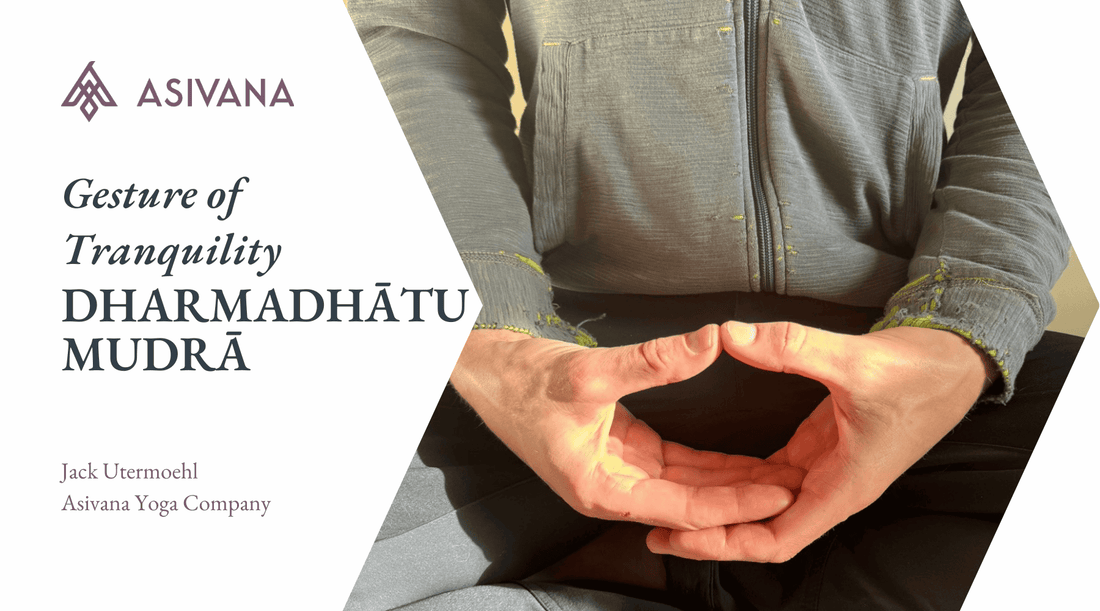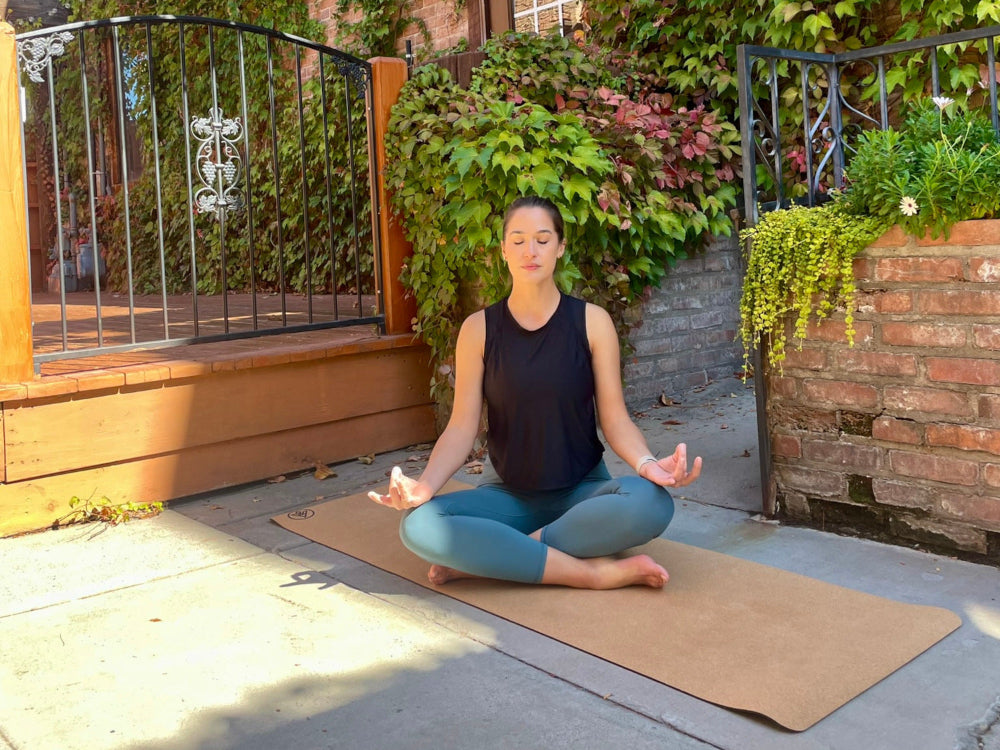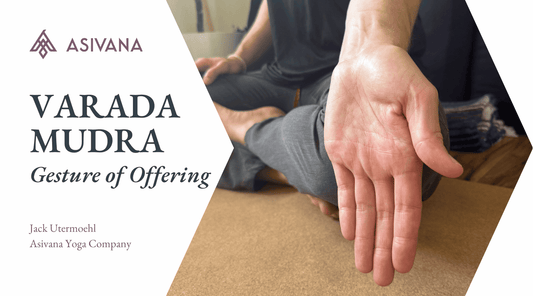
Dharmadhatu Mudra - Gesture of Tranquility
Jack UtermoehlShare
Dharmadhatu Mudra (Gesture of Tranquility)
Sanskrit Name: Dharmadhātu Mudrā - धर्मधातु मुद्रा
English Translation: Gesture of Tranquility
Phonetic Spelling: Dhar-mah-DAH-too Moo-Drah
Dharmadhatu mudra, or the gesture of tranquility, is a deeply meditative hand gesture that represents the essence of universal truth or the “realm of phenomena” (dharmadhatu). It signifies the boundless, tranquil nature of reality, inviting practitioners into a state of inner peace and deep connection to the greater universe.
This mudra is often used in Buddhist meditation practices to cultivate tranquility, wisdom, and insight.
In this mudra, the practitioner’s hands form a gesture that symbolizes openness and receptivity to the infinite, encouraging a state of calm, stillness, and insight during meditation.

Instructions to Perform Dharmadhatu Mudra
Sit in a comfortable position with your spine upright and your body relaxed. Create a calm, meditative space around you.
Hand Position: Place your hands in your lap with the palms facing upward. The right hand rests on top of the left, with both thumbs gently touching to form an oval shape. The hands should be relaxed, forming a gentle bowl.
Posture: Sit in sukhasana (easy pose) or padmasana (lotus pose) for grounding. Alternatively, if seated in a chair, ensure your feet are flat on the ground, and your spine is upright.
Breathing Technique: Inhale deeply and slowly through the nose, allowing your breath to fill the belly. Exhale gently, focusing on letting go of any tension or distractions. As you breathe, bring your awareness to the peaceful sensation of your hands resting in this tranquil mudra.
Duration: Practice dharmadhatu mudra for 15-60 minutes during meditation, concentrating on cultivating stillness and inner peace.
Benefits of Dharmadhatu Mudra
Dharmadhatu mudra is a powerful tool for cultivating inner tranquility, wisdom, and deep meditative states. It enhances focus, encourages insight, and facilitates a connection to the universal truth.
Physical Benefits: Creates relaxation and helps release physical tension, especially in the upper body and hands. Encourages deep, calming breaths.
Mental Benefits: Enhances focus, mental clarity, and insight. Reduces distractions, allowing for deeper meditation.
Emotional Benefits: Cultivates emotional calm and stability by helping the practitioner access a state of deep peace.
Spiritual Benefits: Supports spiritual awakening by connecting the practitioner to the realm of universal truth and wisdom. Evokes deep meditative states and insight into the nature of reality.
Capture your insights and deepen your connection with our Yoga Journal.Elevate Your Mudra Practice
Symbolism and Meaning of Dharmadhatu Mudra
Dharmadhatu refers to the "realm of phenomena" or the ultimate nature of reality. By practicing dharmadhatu mudra, the practitioner symbolically embraces the infinite and tranquil nature of existence.
The hands form a bowl-like shape, representing openness and receptivity to the universe and its wisdom. This mudra encourages the practitioner to enter a space of quiet reflection and deep meditation, allowing for the dissolution of the ego and connection with the greater cosmos.
When to Practice Dharmadhatu Mudra
Dharmadhatu mudra is ideal for use during deep meditation sessions, particularly when seeking inner stillness, tranquility, and spiritual insight. It is useful in moments of mental or emotional turbulence, as it fosters peace and calm.
Practice this mudra when seeking a deeper connection to your meditation practice or during mindfulness sessions to enhance focus and stillness. It can also be helpful when trying to access deeper wisdom and insight.
A duration of 15-60 minutes is recommended for meditation.
Contraindications for Dharmadhatu Mudra
Dharmadhatu mudra is gentle and safe for all practitioners, with no significant contraindications.
Additional Insights on Dharmadhatu Mudra
Affirmations: "I am open to the infinite tranquility of the universe." / "I rest in the wisdom of universal truth."
Visualization: As you hold dharmadhatu mudra, visualize a vast, open sky stretching out in all directions, representing the boundless nature of the universe. Allow yourself to sink into this tranquil space.
Associated Chakras: Dharmadhatu mudra primarily activates the Sahasrara (crown chakra).
Paired Asanas: Works well with seated postures such as sukhasana (easy pose) or padmasana (lotus pose).
Related Pranayama: Pair with deep belly breathing or ujjayi breath (victorious breath).
Meditation Techniques: Dharmadhatu mudra is ideal for deep meditation practices, including mindfulness or insight meditation.
Variations and Modifications
Alternative Hand Positions: Bhairava Mudra
Adaptations for Beginners: Beginners may start with shorter periods of practice, such as 5 minutes, and gradually increase the time as they become more comfortable with the mudra.
—— 🕉 ——

Personal Insights
Dharma is often translated as "law", "duty", or "the way". This is a de facto meditation mudra that transcends cultures, spiritual practices, and religions similar to Anjali mudra and Jnana mudra.
Dharmadhatu mudra is a great mudra for seeking inner peace through meditation and self-study. By connecting our hands with palms up and thumbs touching, we create a space to hold our focus.
In this focus, we can allow what comes, to be, to observe what is within, and through that observation we can better understand how and why we are.
I love Dharmadhatu mudra because it creates a space to explore myself outside of when those aspects of myself would manifest, such as when I'm feeling anger or sadness. Instead of being stuck in those emotions and playing them out, I have the opportunity to observe those emotions without being attached to them.
Let me know your experience in the comments below.











